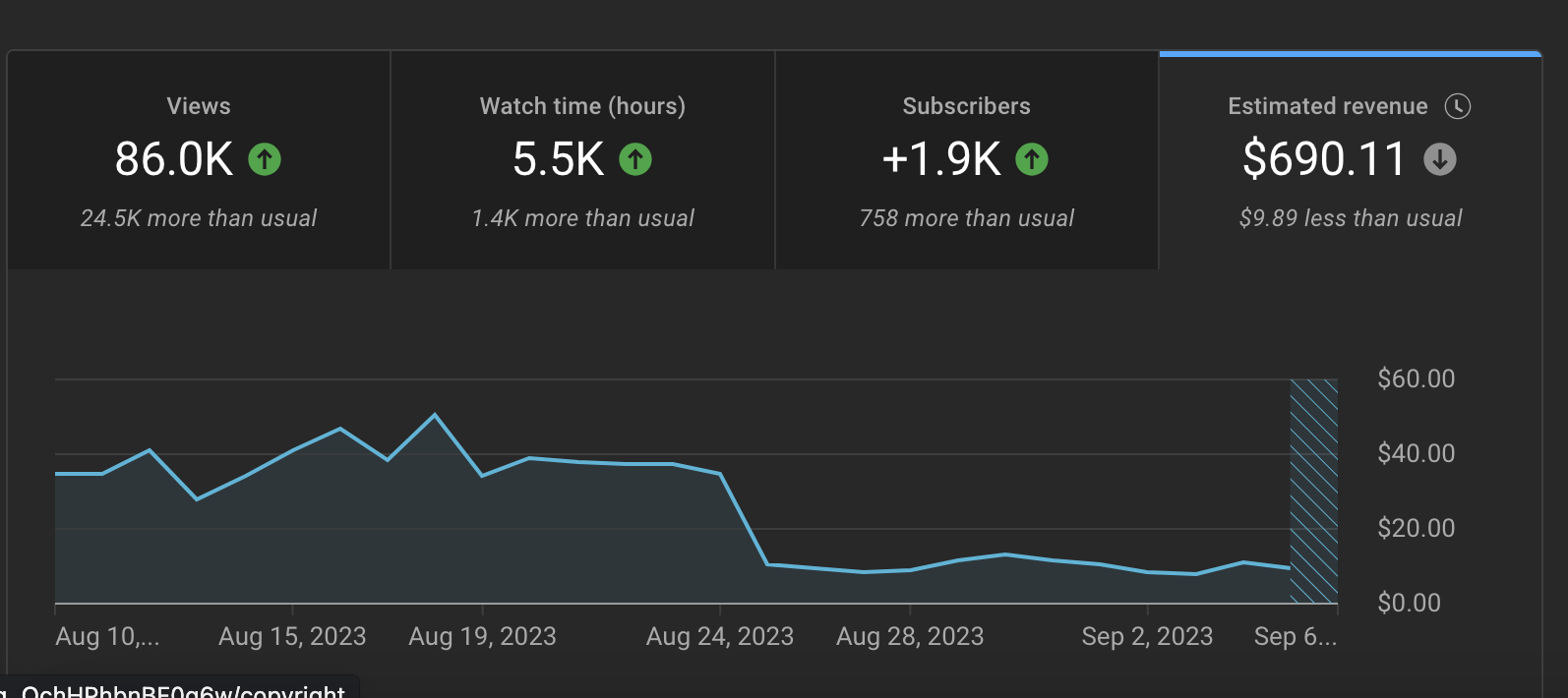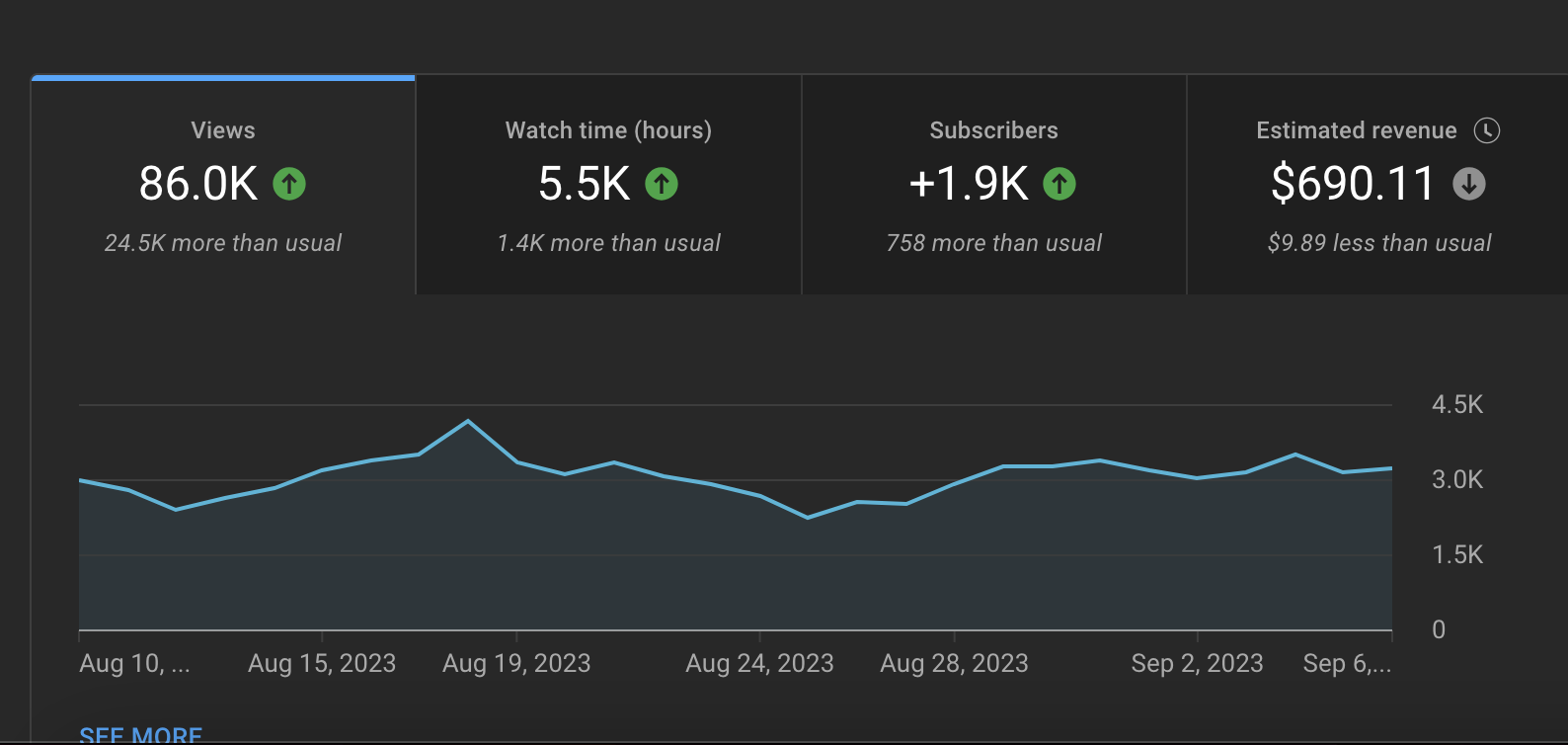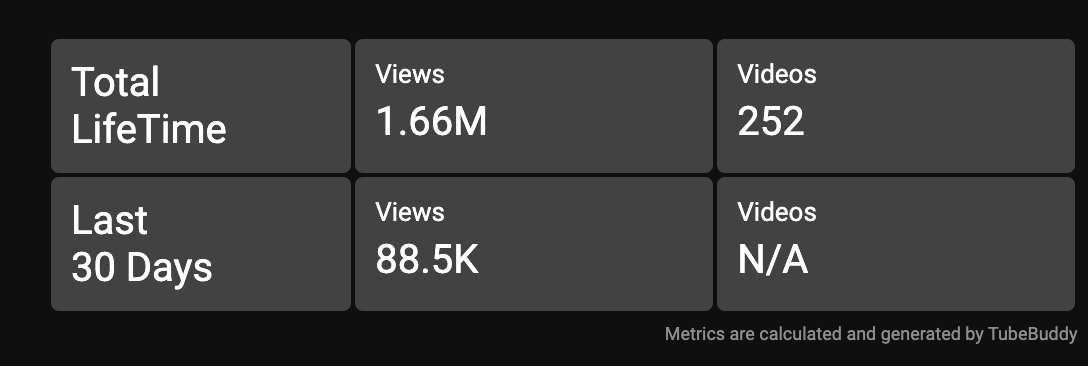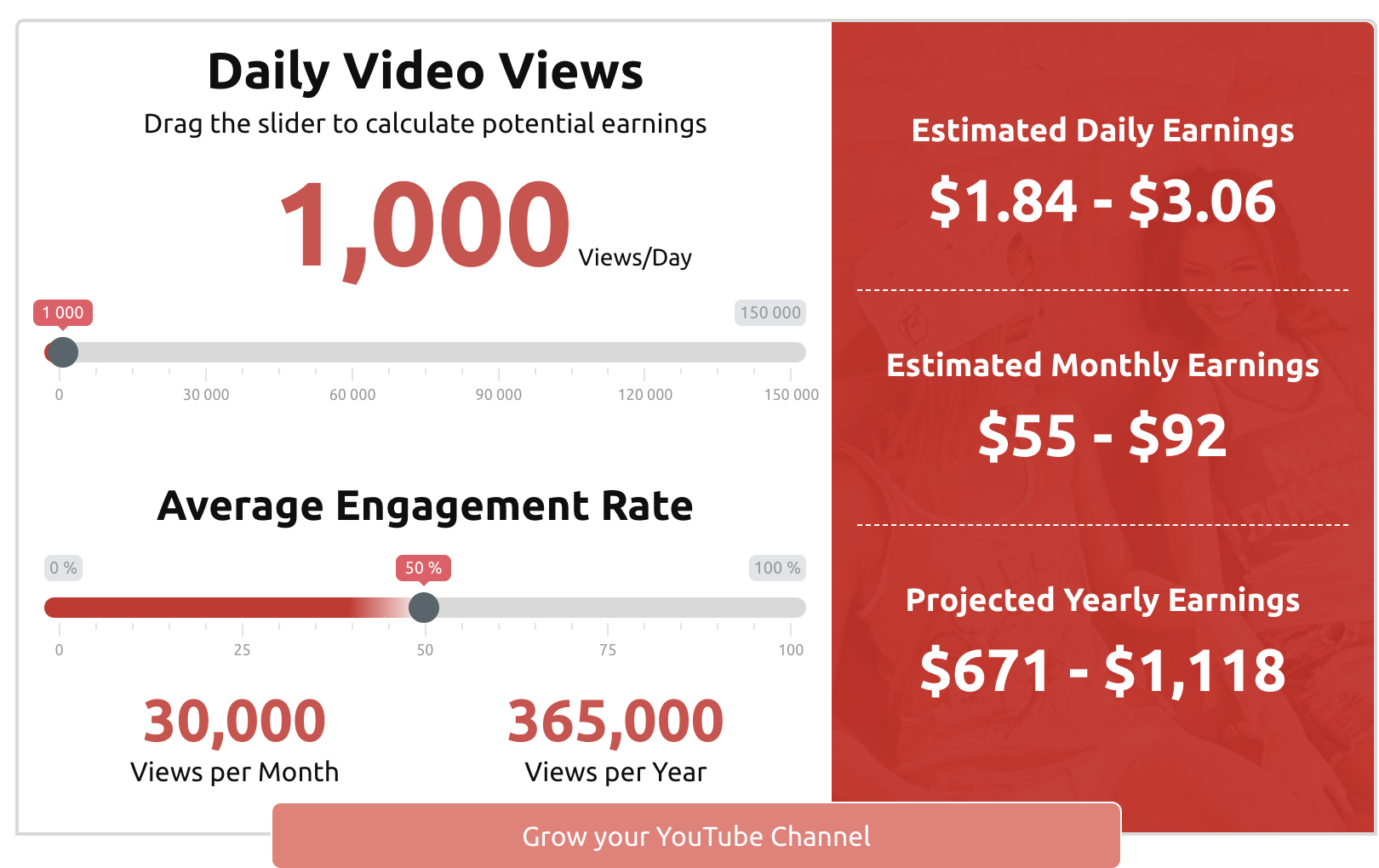How Much Does YouTube Pay?
The short answer? Your favorite YouTuber's YouTube earnings are probably lower than you think.
The longer answer to “How much does YouTube pay?” is that it depends. It depends on the topic of the video, the length of the video, the number of views, and whether the YouTuber in question has any outside sponsorships or affiliate deals.
To illustrate with an example, this past July 2023, I got around 70k views, which netted me $956.26.
This means that YouTube paid me around 1.3 cents per view, or $13 per 1,000 views. This is pretty typical across the industry. Most creators report somewhere between 1 to 3 cents per view.
However, every new subscriber doesn't just represent an ad view; it's also a potential for revenue from other sources. For example, in July of 2023, I also got 174 subscribers to my mailing list on ConvertKit via YouTube, one of whom went on to buy a $217 course. I say this just to illustrate that YouTube pay comes from a variety of sources.
Fellow creators, let's dive into the nitty gritty for how much YouTube pays, including a breakdown of the different sources – from affiliate marketing to Super Chat – and some FAQs.
How the YouTube Partner Program works
Among all social media networks, YouTube was one of the first to monetize creators directly. A YouTube creator is almost always better off than an Instagram or Twitter creator for that reason. YouTube has legacy systems in place to pay us.
When you, a content creator, post a video on YouTube, YouTube basically tells a bunch of advertisers: “Hey, we've got some prime real estate. This creator just uploaded a great video about finance. Her viewers might be interested in finance products. Any takers?”
Then advertisers bid on particular spots on your YouTube video – the banner, the mid-roll, the skippable ad, the super-irritating unskippable ad, and so on.
The advertiser who wins the bidding war pays Google AdSense some amount of money to post it on your content. YouTube then pays you 55% of what the advertiser gave them. They keep the other 45% to keep things running. This is a very profitable business model – YouTube netted around $29 billion in revenue in 2022.
Of course, it gets more complex. Certain content types – like finance – appeal to certain demographics more, which makes that a valuable niche to create videos in. Certain topics are more popular in countries with a lower annual average income, which means advertisers aren't as interested.
But generally speaking, more views generally means that YouTube ads pay more.
How to get into the YouTube Partner Program?
The requirements are based on subscriber count and view time. Get 1,000 subscribers and 4,000 view hours.
It took me about a year to get into the YouTube Partner Program. As soon as I got in, however, I was regularly earning around $250 a month just from the YouTube Partner Program because I already had those 1,000 subscribers and a loyal viewership.
Ways to make money on YouTube
Let's quickly go over all the different methods of making money on YouTube. They're broadly grouped into YouTube branches, like ads, Premium, and Music; creator-to-fan interactions, like Super Chat and Merch; and finally advertiser-to-creator interactions, like affiliate links and sponsorships.
YouTube Channel Membership
This one's easy. You can lock exclusive content behind a membership and earn recurring monthly revenue, a la Patreon.
Ad revenue
The simplest and quickest way to earn YouTube income is through ad revenue on your content. YouTube sells ad space on your videos, you take home a little more than 50%, and everyone's happy.
How much can you earn on YouTube with ad revenue? Somewhere between $100 on the low end to $54 million on the upper end.
YouTube Premium
YouTube implemented this to compete with Netflix and Spotify. Many viewers like me are happy to pay $11.99 a month to watch YouTube without ads to catch up on our favorite “shows” from top creators instead of Netflix, or stream music instead of Spotify. A small portion of that $11.99 goes directly from fan to creator when the fan watches a video.
Not many people choose to do this. Only around 1.5% of my YouTube income comes from YouTube Premium:
In 2022, there were 80 million YouTube premium subscribers. YouTube doesn't share what proportion of that $12 bucks is shared with creators, but one YouTuber anecdotally shared that a view from a YouTube Premium subscriber is worth 8x as much as a view from a non-Premium user.
YouTube Music
I recently learned about YouTube Music. The basic concept is that you upload music onto YouTube, and YouTube pays you per stream, similar to Spotify. This music is included in the YouTube Premium subscription.
Whipped Cream Sounds blog estimates that, depending on your location, you can earn on average $0.008 per stream, or around $6-$8 for 1,000 streams. You'd need over 13k streams to make $100.
YouTube Short
As of 2022, YouTube Shorts content is eligible for ad revenue, representing YouTube moving away from the YouTube Shorts Fund from 2021-2022 where $100,000,000 was split between all Shorts.
However, creators need 500 subscribers and three million eligible public Shorts views in the last 90 days. A steep ask!
YouTube calculates how much they pay you by pooling all the ad revenue from ads playing between all Shorts, then allocates a percentage based on how many views you have.
Epidemic Sound's blog reports that earnings are around $0.04 per 1,000 views which is over 2x what I'm currently earning. However, they don't cite a source, and YouTube has remained mum on that topic, so who really knows how much YouTube pays for Shorts.
Super Chat
For your Super Fans, there's now Super Chat (and Super Thanks). When you do live streams on your YouTube channel, a viewer can boost their comment right to the top with a super chat by spending somewhere between $1 to $500. YouTube takes a hefty 30% cut of this.
YouTube created this method a few years ago to compete with Twitch on livestreams, which offers Hype Chat. The top Super Chat creators earned literally millions with Super Chat. However, most of the YouTube channel types doing well at this appear to be either anime girls or preachers. If that's you, go in. If not, maybe look for an alternative source.
Merchandise
Want to sell merch, but don't want to be in charge of running a merch shop? YouTube's got you covered.
Some tools like Sellfy (that, spoiler alert, sells merch) estimate that you can earn up to 6x as much money through merch as with ads. However, their estimates should be taken with a pinch of salt since a) they want to convince you to sell merch, and b) they were way off on my revenue estimates for AdSense, so I suspect they are artificially showing low at revenue and high merch revenue.
Source: Sellfy’s calculator
Sponsorships
The second-oldest profession is shilling, aka brand sponsorships. To give you an example of how this works, a brand named SEMRush is paying me a flat $300 to post a video reviewing their new product on my YouTube channel. They don't force me to say something positive, but they're paying me, so I probably will.
I don't normally do sponsorships due to this sort of almost-forced positivity, but I like SEMRush, so I will. Sponsorships are also a great way for early, smaller YouTubers to cut out the middleman and get money directly from an advertiser instead of waiting to get monetized through the Partner Program. No need for an ad view if you're the ad.
Affiliate links
The method is simple: you make a video talking about something. You post an affiliate link to it. If people click on that link and end up making a purchase, you earn a small commission - sometimes as low as 10%, sometimes as high as 50%.
Many a YouTube creator will tell you that the real money is in affiliate marketing. I am not an affiliate marketer, so I personally can't confirm, but we can do some basic math here.
Imagine you create a video about the best espresso coffee grinders. You get 80,000 views on your video. You list 5 affiliate links in the video. Out of those 80,000 viewers, who are actively searching for espresso grinders, let's assume just 1% - 800 - click on a link and buy an espresso grinder.
Source: https://www.youtube.com/watch?v=rfLnDTqFoxk
Let's say the average espresso grinder costs $30, and you get a 10% cut as an affiliate.
800 purchasers of $30 x 10% commision = $2,400. Not bad for a single video. Affiliate marketing definitely beats what creators can earn just from ad revenue alone.
Why you shouldn't rely solely on YouTube views for money
Many creators tuned out after I covered how YouTube earnings pay from ads from a video view. I can almost hear you: “If YouTube just wants to pay me for views, why should I go to all the trouble of setting up affiliate links, sponsorships, merchandise, and so on?”
Let me show you a particularly annoying little message I got:
I don't know what video is causing invalid traffic. I have no idea what could be causing this; the only way I drive traffic to my videos is by using SEO and sending links through my newsletter. There's no way to appeal. And in the meantime, I'm going from ~$30 bucks a day from YouTube earnings to less than ten.
Views are the same, but income dropped by a mile.
This isn't the first time this has happened, or even the second. Like any kind of social media, The YouTube Partner Program has its own rules, and it arbitrates them at its leisure.
They have to keep advertisers happy, and if advertisers think they're not getting enough bang for their buck, they'll complain. And guess who wins in a war between advertisers and creators? YouTube will back advertisers any day of the week, because that's who pays their bills.
This means that how much YouTube pays (at least through the AdSense avenue) depends on rules I don't control or even know about in some cases. It makes sense for creators to look for ways to make money that don't depend on advertisers.
FAQ about How Much Does YouTube Pay
You've got the gist. Now I'll go over a few specific questions to help you understand how much YouTube pays. Remember, these are all rough ideas of how much YouTube pays.
Your YouTube ad revenue depends on your niche, while other factors depend on your views, and others still rely on your ability to do digital marketing like affiliate links.
How much money is 1 million views on YouTube?
For this, I'm going to use the average figure of 1.8 cents per view, since that's what I earn and it's the established mean.
One million views gives you $18,000. That sounds like a lot, yes, but for context that's only slightly more than you'd earn for a year working at minimum wage, which is around $15,000.
In my channel's lifetime, I have earned 1.66 million views. My channel has been going for four years. I've posted 252 videos. You might do better than me! But you might do worse, too.
My own lifetime YouTube analytics stats
How much does YouTube pay per 1,000 views?
Let's look at Influencer Marketing Hub, since they have a YouTube money calculator.
It's interesting that this is much lower than the average estimate of $18 per thousand views, especially since IMH also claims 1.8c per view is the average. Possibly they are underrating it here in order to incentivize you to pay money for their services.
Here's an alternative example for a video of mine with around 1000 views:
And here's another with around the same amount of views, published around the same time:
You can see the niche matters a lot here. Google ads are more profitable when they're served to people who care about money.
I got these screenshots from digging into my own YouTube Studio. You can look for other stats or studies on Influencer Marketing Hub, which is a greta source of info about advertising revenue and has a YouTube money calculator.
How many views do you need to get paid on YouTube?
This depends a lot on your length of videos and the stickiness of your viewers. You know you'll need 4,000 watch hours to get monetized, so let's run a quick thought experiment assuming you'll definitely have 1,000 subscribers by the time you get 4,000 watch hours.
Let's say you upload one video every week of 10 minutes. Let's assume that your video gets 100 views the first week and thus 1,000 watch minutes; your second video gets 200 views; and so on. Each week adds the watch minutes of the previous week.
By week 22, you'd get 22,000 view minutes (AKA 366 watch hours) from that week, plus 3,850 watch hours from the previous 21 weeks. This brings you to your requisite 4,000 watch hours.
This is a very simplified thought experiment, but hopefully helps illustrate how long it might take.
How much does 100k views on YouTube pay?
Again, using our 1.8 cents per view stat, 100k views gets you a neat $1,800 from YouTube.
Though as an alternative example, depending on niche and other factors, let's pop into my Youtube analytics to compare two examples that don't match this rule.
On the high end, this video with 130k views has made me around $3.2k.
Meanwhile, this video with 140k views has made me $1.7k.
And of course if you have alternative sources – affiliate links, sponsorships, merch – that number goes up.
What social media networks are good YouTube alternatives?
For uploaded video, there just aren't many good alternatives. Instagram shorts don't pay as well, or as reliably. Twitch is good for live streams, but not recorded content. Other competitors just don't have the existing audience that YouTube does.
What counts as a YouTube view?
Let’s go straight to the source. This is what Google AKA YouTube says about what counts as a YouTube paid view:
Paid views reveal the number of times viewers view a larger portion or the entirety of your ad, beyond just the impression.
In-stream ad views: This metric is counted when the viewer watches 30 seconds or until the end of the video, whichever comes first. Interactions on the ad can also increment the view count.
For example, the following count as a view for in-stream ads:
A viewer watches the entirety of a 20-second video ad.
A viewer watches 32 seconds of a 40-second video ad.
A viewer clicks an interactive element of the ad at 18 seconds (which is both a click and a view increment) of a 20-second ad.
What does it take to get YouTube monetization?
As I mentioned: the hard requirements are 4,000 watch hours and 1,000 subscribers. It's steep.
To get that, you'll need:
A real enjoyment of making videos. It is hard, unpaid work to start. If you don't love it, you'll burn out.
An audience acquisition strategy. Do you have an existing audience? Do you know anything about SEO? Are you tapping into an underserved niche? I highly recommend Annie Dubé's strategy videos if you're not sure where to start.
Determination. Lord, it sounds cliche, doesn't it? But genuinely, you're going to run into days when you don't feel like filming. If you're successful, you'll get comments that make you want to shred your fingertips (or theirs). You'll be penalized by YouTube for something you didn't do. A successful YouTuber needs grit to stick it out.
In sum: YouTube pays ~1.8 cents per view. You can earn more. You'll probably earn a lot less unless you have staying power. There are tons of different ways to monetize. And if you love making videos, there's no better place to be.














